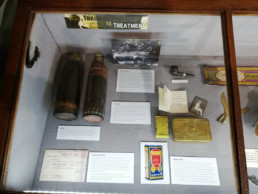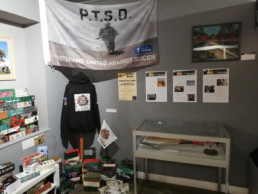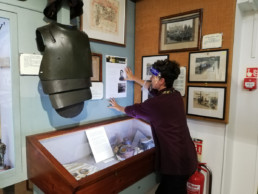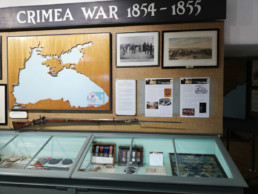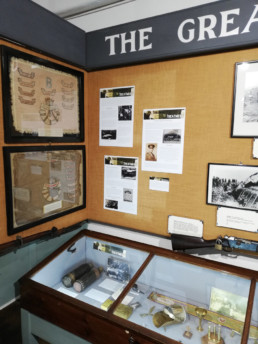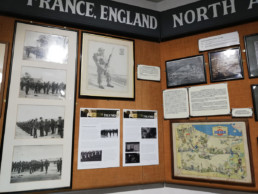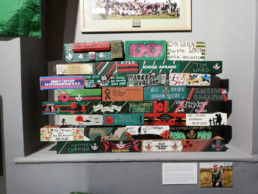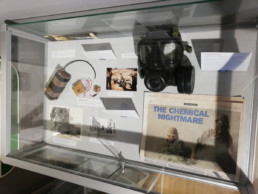TRAUMA TO TREATMENT
CURATED BY SARAH WAITE AT BODMIN KEEP
War leaves mental scars as well as physical ones. But the impact of combat on the mind has been a contested topic. Since the 19th century, military medics have made diagnoses ranging from ‘Soldiers Heart’ to ‘Shell Shock’. Psychiatric understanding of the causes, symptoms and treatment of mental trauma has been wide-ranging and often influenced by military priorities. This exhibition explores the development in understanding and treatment of mental health conditions caused by the impact of conflict.
Medical officers and army commanders were often unsympathetic to soldiers struggling with their mental health. Many people slipped through the cracks. It is only within the last few decades that conditions such as Post-Traumatic Stress Disorder (PTSD) have been officially recognised as a detrimental consequence of military service. Mental ill-health can happen to anyone, even the toughest, most hardened soldiers. With more service personnel and veterans reaching out for support than ever before it is crucial that we take mental wellbeing seriously. The battles do not always end when the guns stop firing. Trauma to Treatment unravels the history of military psychiatry and the experiences of soldiers past and present who fought wars on the ground and in their own minds.
CURATORIAL TASK: REFLECTIVE WRITING
After months of applying for entry level jobs in the museum sector, between shifts stacking books in a library and pulling pints at a pub, I was finally offered a curatorial traineeship at a small military museum. Leaping at the opportunity, in January 2020 I uprooted my life in South London and moved to Bodmin, Cornwall. Once I had gotten over the shock of hearing owls outside my bedroom window and seeing tractors driving on the road, I was ready to throw myself in to my new life and new job.
The ‘Trainee Curators’ programme was funded and organised by Cornwall Museums Partnership. There were five of us trainees in total, all placed in different museums across the county. Bodmin Keep: Cornwall’s Army Museum was my host organisation. Run by a dynamic team of motivated and characterful women, Bodmin Keep completely defied my expectations of a rural regimental museum. Whilst working there, I was not only gaining curatorial experience, but the team ensured that all doors were open. I was invited into strategic planning meetings and encouraged to ask questions relating to governance, learning and engagement, and marketing and communications.
The team at the Keep were enthusiastic about my ideas to embark on projects that would diversify our museum displays and digital content. For example, I participated with a podcast the museum produced which explored the Army’s LGBTQ + history. I pitched an idea for a new display which interrogated some of the colonial collecting stories behind some of the objects in our collection. I launched a mini-series of videos which looked at artworks within our collection using the principles of mindfulness. But the project which really captured my attention was the opportunity to curate an exhibition of my own. The topic: mental health in the military.
The subject of mental health and psychiatric casualties of war is woefully underrepresented in military and regimental museums, despite being one of the most crucial issues for veterans and service personnel today. Bodmin Keep has a significant community presence and a platform to make a change. I hoped that an exhibition could raise awareness of the mental health challenges faced by the military family, myth-bust, encourage empathy, challenge social stigma, and encourage veterans and other members of our local community to access support if they need it. I also hoped that an exhibition on mental health could challenge entrenched ideas about regimental museums as being too conservative or irrelevant to the issues of today’s society, inviting attention from new audiences.
The exhibition has been collaborative in nature. I was keen to work with veterans within our ex-Light Infantry community, for whom we hold the regimental collection. I have had the opportunity to work with some fascinating people, who have been donating objects and stories to the exhibition. Navigating these relationships was challenging at times, given the sensitive and emotive nature of the topic. However, the experience was rewarding and has offered me an insight into the power that museums have over the way in which histories are told and who’s heritage gets remembered.
Not only has my traineeship given me the opportunity to grow as a curator, but I feel that I have left my mark on the museum in return. I have undertaken many museum internships in the past, most of which have involved staring into space in empty galleries for hours or acting as a human coat rack. However, a traineeship which enables the trainee to leave a genuine impact on an organisation is very special, and I encourage any entry level museum professional to seek these out. Even if it does mean moving somewhere a little bit unexpected.
